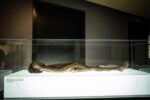Michael Bevilacqua – Electrical Chapel: the Spiritual in Art
-scaled.jpg)
Con “Electrical Chapel: the Spiritual in Art” approda ora al tema del sacro in arte, grazie a una collisione intenzionale tra l’opera di Mark Rothko e le parole e la musica pop di Lana Del Rey, affascinato dal modo in cui la cantante utilizza riferimenti bibliografici mescolandoli a citazioni da Walt Whitman.
Comunicato stampa
Michael Bevilacqua inaugura il suo 4° show alla galleria the Flat - Massimo Carasi con un nuovo turbinoso giro di barra, l’ennesimo ciclo pittorico.
L’artista ha abituato il pubblico e i suoi estimatori a costanti cambi di direzione: chiude un ciclo per andare oltre, in una costante ricerca e sintesi del sentire contemporaneo, quindi, dopo alcuni anni di sperimentazione, è la pittura spray che domina la sua più recente produzione, con il dichiarato intento di portare il mezzo oltre l'idea dei graffiti.
La cifra costante rimane l'inesauribile produzione di temi e associazioni.
Il mish/mash di alta e bassa cultura nelle tele di Bevilacqua diviene ancora una volta la forza guida che intercala logos, frasi di canzoni e citazioni colte.
Con "Electrical Chapel: the Spiritual in Art” approda ora al tema del sacro in arte, grazie a una collisione intenzionale tra l’opera di Mark Rothko e le parole e la musica pop di Lana Del Rey, affascinato dal modo in cui la cantante utilizza riferimenti bibliografici mescolandoli a citazioni da Walt Whitman.
Bevilacqua si riafferma come raffinato colorista: l’associazione imprevedibile di colori e tonalità torna a caratterizzare questo ciclo a cui aggiunge la sensualità tattile del velluto delle superfici spolverate con pittura spray. Le campiture di colore si presentano talvolta come lo sfondo su cui sono adagiati testi e parole, in altre è la cancellazione stessa delle frasi che genera sovrapposizioni di porzioni di colore, ricreando in entrambi i casi evidenti rimandi stilistici alle opere di Rothko: il risultato è un’interessante tensione tra linguaggio e astrazione.
In mostra alcune tele presentano composizioni in cui si contrappongono esclusivamente l’oro e il nero. L’oro rappresenta la bellezza naturale del metallo mentre il nero corrisponde il buio che troviamo nella maggior parte delle chiese: un buio atmosferico più che metaforico.
Bevilacqua afferma: " viviamo in un mondo in cui siamo costantemente assaliti da immagini e come recitano i Kraftwerk, viviamo in un computer, esiste comunque un rinascimento delle arti che ci sta portando verso la “spiritualità nell'arte". Le nostre case sono diventati i nostri santuari e i nostri ritiri.
“Electrical Chapel: the Spiritual in Art”
Michael Bevilacqua inaugurates his 4th exhibition at The Flat - Massimo Carasi with another whirling turn of the wheel, in yet another pictorial cycle.
The artist allows the public and his admirers to become used to constant changes of direction – closing a loop, only to go further in a constant search for and synthesis of contemporary feeling. Thus, after a few years of experimentation, spray paint dominates his most recent production, with the declared intention of taking the medium beyond the stereotypical idea of graffiti.
The figure remains a constant production of inexhaustible themes and associations.
The mish / mash of high and popular culture in the paintings of Bevilacqua once again becomes the driving force, interposing logos, phrases, songs and intellectual quotes.
With "Electrical Chapel: the Spiritual in Art", the topic of the sacred in art comes into view, thanks to a deliberate collision between the work of Mark Rothko and the lyrics to the pop music of Lana Del Rey, whose use of bibliographic references mixed with quotes from Walt Whitman fascinates the artist.
Bevilacqua re-affirms his ability as a refined colourist: his unpredictable combination of colours and shades return to characterise this cycle, to which he adds the tactile sensuality of a velvety surface dusted with spray paint. Fields of colour sometimes feature as a background on which texts and words are strung out, while in other works, colour acts to cancel out the same phrases and generate overlapping tonal fragments. In both cases, the artist recreates obvious stylistic references to the work of Rothko, creating intriguing tension between the concepts of language and abstraction.
In this show, some paintings feature compositions that consist exclusively of gold and black. The gold represents the natural beauty of the metal while the black corresponds to the darkness that we find in most churches: an atmospheric darkness rather than metaphorical shadow.
Bevilacqua states: "We live in a world where we are constantly assaulted by images, and as (the group) Kraftwerk recites, we (now) live in a computer, however, there is a renaissance of the arts that is leading us toward "spirituality in art". Our homes have become our sanctuaries and our retreats.
Michael Bevilacqua (1966 USA) vive e lavora a / lives and works in New York City
Le sue opere si trovano nelle collezioni permanenti di:
His works can be seen in the permanent collections of:
Dallas Museum of art Dallas Texas
The Whitney Museum of Art NYC
Deste Foundation Athens Greece
Louisianna museum Humlebeak Denmark Copenhagen
Astrup Fearnley Museum Oslo Norway
San Francisco museum of art San Francisco CA
Neuberger Bermann NYC
St Louis Museum of art. St. Louis Missouri
Tel Aviv Museum of art. Tel aviv Israel
Orange County Museum of art CA
Mitsuni Collection Tokyo Japan



